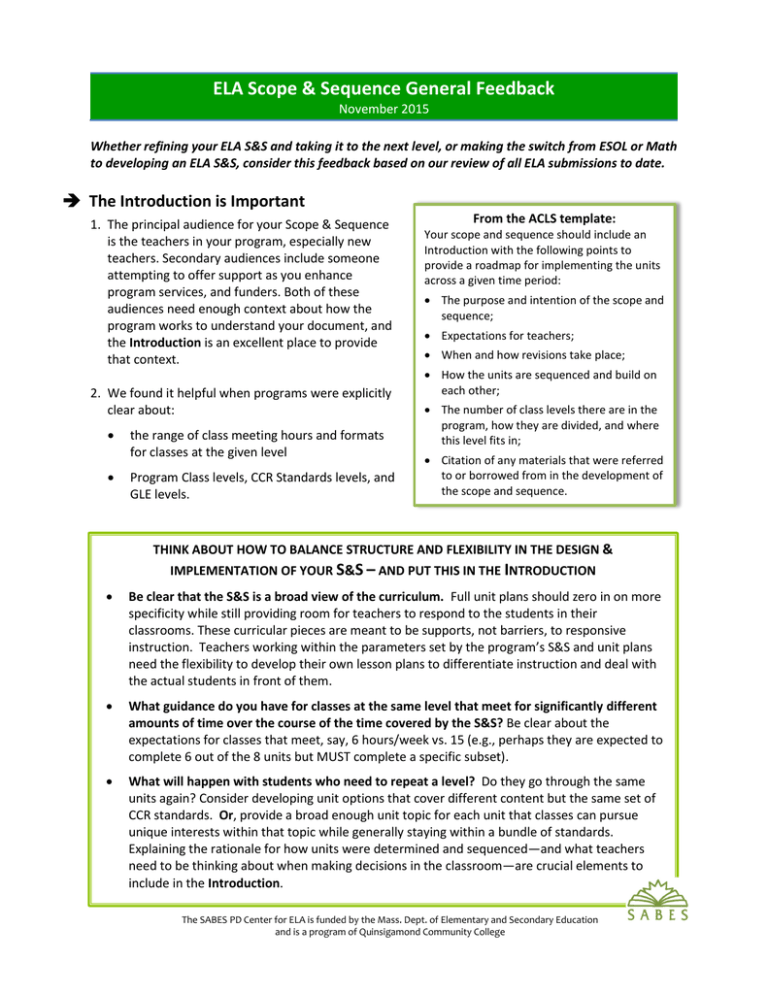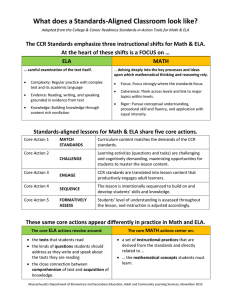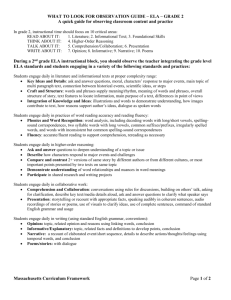ELA Scope & Sequence General Feedback
advertisement

ELA Scope & Sequence General Feedback November 2015 Whether refining your ELA S&S and taking it to the next level, or making the switch from ESOL or Math to developing an ELA S&S, consider this feedback based on our review of all ELA submissions to date. The Introduction is Important 1. The principal audience for your Scope & Sequence is the teachers in your program, especially new teachers. Secondary audiences include someone attempting to offer support as you enhance program services, and funders. Both of these audiences need enough context about how the program works to understand your document, and the Introduction is an excellent place to provide that context. 2. We found it helpful when programs were explicitly clear about: the range of class meeting hours and formats for classes at the given level Program Class levels, CCR Standards levels, and GLE levels. From the ACLS template: Your scope and sequence should include an Introduction with the following points to provide a roadmap for implementing the units across a given time period: The purpose and intention of the scope and sequence; Expectations for teachers; When and how revisions take place; How the units are sequenced and build on each other; The number of class levels there are in the program, how they are divided, and where this level fits in; Citation of any materials that were referred to or borrowed from in the development of the scope and sequence. THINK ABOUT HOW TO BALANCE STRUCTURE AND FLEXIBILITY IN THE DESIGN & IMPLEMENTATION OF YOUR S&S – AND PUT THIS IN THE INTRODUCTION Be clear that the S&S is a broad view of the curriculum. Full unit plans should zero in on more specificity while still providing room for teachers to respond to the students in their classrooms. These curricular pieces are meant to be supports, not barriers, to responsive instruction. Teachers working within the parameters set by the program’s S&S and unit plans need the flexibility to develop their own lesson plans to differentiate instruction and deal with the actual students in front of them. What guidance do you have for classes at the same level that meet for significantly different amounts of time over the course of the time covered by the S&S? Be clear about the expectations for classes that meet, say, 6 hours/week vs. 15 (e.g., perhaps they are expected to complete 6 out of the 8 units but MUST complete a specific subset). What will happen with students who need to repeat a level? Do they go through the same units again? Consider developing unit options that cover different content but the same set of CCR standards. Or, provide a broad enough unit topic for each unit that classes can pursue unique interests within that topic while generally staying within a bundle of standards. Explaining the rationale for how units were determined and sequenced—and what teachers need to be thinking about when making decisions in the classroom—are crucial elements to include in the Introduction. The SABES PD Center for ELA is funded by the Mass. Dept. of Elementary and Secondary Education and is a program of Quinsigamond Community College Strive for Clarity with the CCR Standards 3. ACLS gives programs the option of using CCSS notation for K-12 (listed in parentheses at the end of level-specific standards in the CCRS), or the notation guidelines at right (), which make it easier to locate a standard within the CCRS. 4. Some programs divided their standards into Priority Standards and Secondary Standards on the Standards Matrix at the end of the Scope & Sequence template. Categorizing standards in this way (or something similar) helps teachers to think carefully about what they are teaching with explicit, scaffolded instruction versus what is being revisited and practiced from previous units. This differentiation may cut down on the “laundry list” of “priority” standards. Including Priority and Secondary Standards in planning and in the matrix: Where’s that standard??? (1) Note the Strand (R for Reading, W for Writing, SL for Speaking and Listening, L for Language, or RF for Reading Foundations) (2) Reference the Anchor Standard # (3) Note the Level (A through E) (4) If needed, note the specific skill within that standard (small letters a, b, c, etc.) Level-specific examples: W7B = "Conduct short research projects that build knowledge about a topic." SL1Cc = “Pose and respond to specific questions by making comments that contribute to the discussion and elaborate on the remarks of others.” o Permits a more transparent “spiraling” approach, in which standards are intentionally revisited again and again across units to promote ongoing development. o Allows a program to truly see what skills are being developed versus “covered.” o Allows new students to be introduced to standards that might have been addressed earlier in the academic year. Keep These Additional ELA Issues in Mind 5. CCR Standard R1 should probably be the focus of instruction (a Priority Standard) in the first unit or two and then listed at least as a Secondary Standard for several units thereafter. 6. Building academic vocabulary (R4/L6) should be part of every unit starting at Level C. Build on/weave together these domains into thematically-connected, project-based units: Science Social Studies Literature Job & Career Readiness Life-long Learning Citizenship / Participation in Society 7. Don’t forget Literature! Most programs did an excellent job using a topical/thematic approach to the units—and incorporating a mix of themes. Incorporate literature into these units when possible, in addition to rich non-fiction texts. The CCRS emphasis on informational texts does not translate to entirely ignoring literary texts. 8. Different levels need a different emphasis: Lower ABE levels: Remember the Foundational Skills for Reading. Also, incorporate authentic texts (e.g., can labels, prescriptions) that adults at this level need to read. Students in Level D & E (ASE) should have W1 and W2 as a significant part of almost every unit. Informational and argumentative writing are both difficult to develop; look at the level standards to see what complex skills they are. Students will not “master” either of these standards in one unit, so we we encourage most units in Level D and E to address one of these standards.


